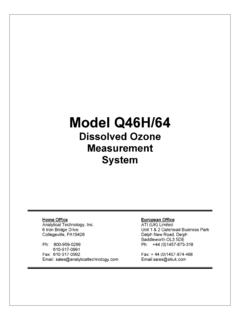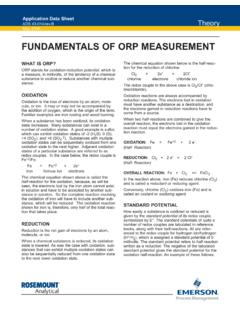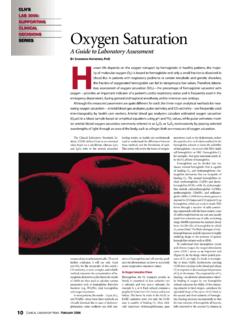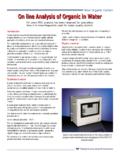Transcription of Measurement of Phosphate in Water - Roems
1 Purpose of the Measurement : Fluctuations in the cooling Water mix can occur due to changes in the make-up Water quality and also due to evaporation. The monitoring and control of cooling Water chemicals using process instrumentation allows higher reliability of operation, optimized consumption of cooling Water chemicals and increased protection against corrosion and formation of deposits and thus reducing operating costs. Proper maintenance and economy of operation of cooling towers require a careful balance between Water quality parameters and treatment chemicals.
2 Measurement of Phosphate in Water Application Background: Cooling towers are used by office buildings and manufacturing plants throughout the world to dissipate waste heat from air conditioning, industrial and power generation processes. Recirculating Water transfer thermal energy from the building or industrial process to the atmosphere. Atmosphere air blown through the cooling tower carries away the heat. Re-circulated cooling Water must be treated to remove impurities and dissolved hydrocarbons. Because the Water is saturated with oxygen from being cooled with air, the chances for corrosion are increased.
3 One means of corrosion prevention is the addition of a material to the cooling Water that forms a protective film on pipes and other metal surfaces. This prevention of corrosion on metal surfaces is achieved by adding corrosion inhibitors. Typical inhibitors used are: phosphates, ploynitrite, organonitrite and chromates. 260A Bear Hill Road Waltham, MA 02451 USA Principle of operation: The sample is pumped into the reaction cell where a Measurement of the sample is first recorded in order to compensate for any background color in the sample.
4 Reagent is then pumped into the measuring cell; a change in color and intensity occurs if orthophosphate ions are present. The color change of the solution is measured with a built-in colorimeter. Results are converted to units of orthophosphate and displayed on the LCD readout. I F I C A T I O N S The system is designed for both accuracy and economy. The analyzer typically consumes less than one liter of each reagent per month . The reagent is easily replenished without interrupting operation. The system provides automatic reliable analysis unattended typically for up to 31 days.
5 A menu-driven interface makes it easy to set all functions. The Phosphate analyzer provides an affordable and reliable tool to monitor reactive Phosphate usually termed orthophosphate. Early detection of changing orthophosphate levels enables the operator to quickly implement process corrections, thus reducing the cost of plant operation and to ensure that proper operating limits are met. Phosphate Method of Analysis: The chemistry is based on the Vanadomolybdophosphoric Acid Colorimetric Method as found in Standard Methods.
6 ASTM D 515-82, Phosphorous in Water , Test Method C. Mixing reagent with sample, a color change indicates the presence of orthophosphate. More specifically, orthophosphate (PO4) under acidic conditions and in the presence of vanadate-molybdate reagent forms vanadomolybdophosphoric acid. This yellow product is measured by the colorimeter. 260A Bear Hill Road Waltham, MA 02451 USA Key features include Heated reaction cell block assembly to maintain full temperature control over chemical reaction and stable optical Measurement system.
7 Low reagent consumption. Programmable parameters to customize operation and optimize performance with minimum chemistry background. Programmable frequency of analysis and Automatic calibration. Large LCD graphical display with clear readability under different light condi-tions. Data logging and trending: Statistics for up to 31 days, previous 7 days, or previ-ous 24 hours are logged and can be viewed in graphical format. Auto blank feature to eliminate interfer-ence from sample background color fluc-tuations. Minimal maintenance requirements to maximize up time.
8 Multi-language. (English and Chinese) Easy to Maintain Using pinch valves and peristaltic pumps, only the tubes come into contact with the sample, thus minimizing maintenance. All tubing, parts, and reagents are visible, accessible, and easy to replace when necessary. Minimal reagent consumption and user serviceability result in a low cost of ownership. Each monitor is pre-piped and pre-wired, requiring only field connection to service points. A clear layout of all liquid processing components allows for easy access and all controls are manageable from the front of the unit.
9 Software and Graphic Display The systems are operated with menu-driven convenience, and results can be displayed numerically or graphically on the LCD display. User Interface Easy access of all parameters is provided via a large backlit LCD graphics display module. Under normal operating conditions the measured value is displayed. Units of Measurement , alarm values and calibration standard solution values are examples of the many programmable functions. The operation of the monitor is made straightforward through tactile membrane keypad controlling the complete operation of the monitor.
10 There are two isolated current outputs provided as standard with a serial RS-232 interface. 260A Bear Hill Road Waltham, MA 02451 USA Installation The monitor series is designed for easy wall mounting, indoors. Adequate clearance must be allowed at the sides and bottom of the instrument case for plumbing and wiring connections. The monitors are constructed of low-weight, corrosion resistant materials and are modular in design for serviceability and ease of maintenance. General Specification Suspended solids < 60 microns Sample connections Inlet Outlet 1/4 inch OD flexible tubing Sample Inlet Pressure 1 to 5 psi Sample temperature 5 to 50C (40 to 122F).








